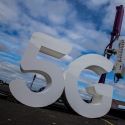
While carriers are bragging that 5G will boost speeds up to 100x over LTE, the reality falls far short of that hype -- at least for now, according to a report by network monitoring firm OpenSignal.
T-Mobile, for example, boasts that 5G will support 10x faster speeds for mobile broadband. And CTIA, the US wireless industry's trade association, crows that 5G will be up to 100x faster than 4G.
Well, the initial results are in, and the reality doesn't quite match up to the hype. At least not yet.
According to OpenSignal, 5G services in the US are around 2.7x faster than 4G LTE services. Specifically, the firm said that it recorded maximum download speeds in the US of 1.8 Gbit/s on 5G, which was 2.7x faster than the 678Mbit/s maximum download speeds it recorded in the US on LTE networks.
Figure 1: 
OpenSignal noted that US operators provided the highest maximum 5G download speeds of the eight countries where it recorded results. "Switzerland followed in second place with 1145 Mbps and South Korea ranked third with 5G users’ maximum speed of 1071 Mbps," the firm wrote. "The speeds we measured in these three leading countries were significantly faster than the maximum speed in European markets where 5G has only just launched, such as Italy or Spain, or in the UK where the first operator to launch 5G only has 40MHz of suitable spectrum, which is far below 5G technology's 100MHz channel size sweet spot."
There's a simple reason the US recorded such high speeds: "Operators there are already able to use mmWave [millimeter-wave] spectrum for 5G," the firm wrote. "This is extremely high capacity and extremely fast spectrum but has very limited coverage compared with the 3.4-3.8GHz 5G 'midband' spectrum typically used in most of the other countries we analyzed, where mmWave spectrum is not yet available."
OpenSignal said it recorded its findings between April 1 and June 30. The firm did not provide details on the operators providing the speeds, but it's reasonable to assume that Verizon and AT&T are the operators behind OpenSignal's US results, as they were the only ones offering 5G services in mmWave spectrum during the firm's timeframe. OpenSignal obtains its network-performance data via applications installed on customers' phones.
OpenSignal isn't the only company offering a real-world look at 5G speeds in the US. For example, PCMag has taken in-depth looks at the performance of 5G across the nation's major wireless operators, as has Cnet.
Results generally indicate that operators' 5G speeds and coverage directly correlate to the types and amount of spectrum they're employing. Higher-band spectrum can support faster speeds while lower-band spectrum can support broader coverage areas. That's why AT&T has boasted of 5G speeds above 2 Gbit/s on its mmWave spectrum while T-Mobile has warned that 5G speeds on its 600MHz spectrum will hover around 60 Mbit/s.
To be clear, there's little doubt that overall 5G speeds will increase, just as they have on LTE. Indeed, initial LTE networks in the US launched with speeds of around 5 Mbit/s, and today US LTE speeds can sometimes exceed 100 Mbit/s or more.
"Opensignal expects 5G maximum speeds to continue to increase as 5G expands its reach," the firm wrote. "This is just the start of the 5G era and the market is moving quickly. More 5G services will launch using more spectrum and wider channels -- there are few 5G services currently using 5G's ideal 100MHz channel size -- and 5G technology evolves to be able to combine the performance of multiple 5G channels and bands together to boost both the maximum and average 5G speeds and further improve the mobile user experience of 5G users."
— Mike Dano, Editorial Director, 5G & Mobile Strategies, Light Reading | @mikeddano
About the Author(s)
You May Also Like











